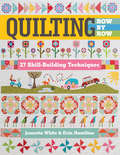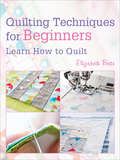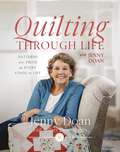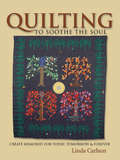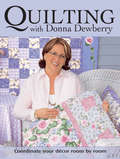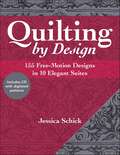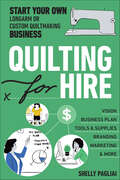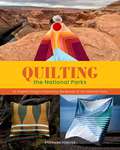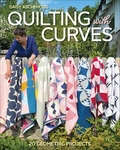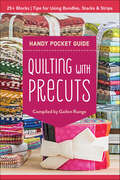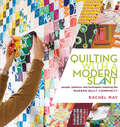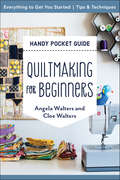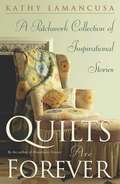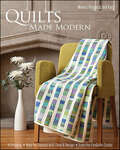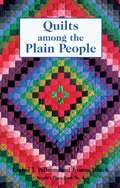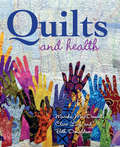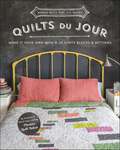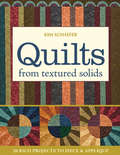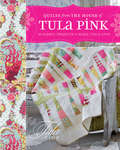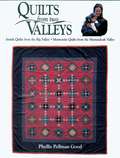- Table View
- List View
Quilting Row by Row: 27 Skill-Building Techniques
by Jeanette White Erin HamiltonDresden plates, pinwheel blocks, Flying Geese . . . work your way up until you&’re piecing like a pro! Starting with the simplest patchwork squares and working your way up to more challenging appliqué and paper piecing, you&’ll sew through a cheery eleven-row sampler quilt and two bonus projects. Build 25 specific quilting skills such as getting an accurate ¼˝ seam, constructing on-point squares, and using the 45° angle on a ruler. Straightforward how-to photos and links to full-size patterns are included. Gain confidence and learn new tips along the way, whether you&’re a beginner or a more experienced quilter.
Quilting Techniques for Beginners: Learn How to Quilt
by Elizabeth BettsLearn how to quilt with the fantastic guide to quilting for beginners by Liz Betts. Start by learning the basics of piecing and how to use a rotary cutter, then making a quilt sandwich, quilting, and finally, binding your new project! A fantastic guide for anyone looking to start a new hobby, Quilting Techniques for Beginners will have you quilting in no time!
Quilting Through Life: Patterns and Prose for Every Stage of Life (Spiral Bound to Lay Flat)
by Jenny DoanStep-by-step quilting instructions and personal stories to inspire both seasoned pros and new quilters alike.America's quilter, Jenny Doan, has always believed that quilts are more than fabric and stitches. They become keepers of memories, milestones, and stories; creating profound connections across generations.By alternating personal stories with detailed step-by-step guidance on how you can make quilts for all of life's milestones—from new births, to marriages, to loss and grief—Jenny comes alongside you to share the joy and transformative power of quilting in her passionate and innovative way.With beautiful, full-color images and easy-to-follow diagrams to help you with your own projects, Quilting Through Life is a creative and authentic guidebook to the art of quilting. It's an art designed to be shared with family and friends, crafted from the scraps of memories, laughter, and tears. It's an art that allows us to express how we feel, create something beautiful, and extend the warmth in our hearts to wrap around those we love.From choosing your fabrics and selecting a pattern to creating mitered corners, Quilting Through Life will walk you through how to stitch a legacy of love for every stage of life.
Quilting To Soothe The Soul: Create Memories for Today, Tomorrow & Forever
by Linda Giesler CarltonIn Quilting to Soothe the Soul, you'll learn how quilters through the ages have turned to quilting and sewing to memorialize the significant moments of our lives: the births, marriages, anniversaries, and deaths of our friends and loved ones. Author Linda Carlson shows you how quilting helps relieve the stress of our everyday lives, while it also serves as a means to record the historic events that shape our world. Besides a breathtaking gallery of gorgeous quilts, including pieces designed as a result of September 11, 2001, and the momentous stories behind them, you can choose from over 15 different quilting projects, so you can sew your own memories.When there is stress in your life, turn to your needle and let the labor of your hands work through the grief in your heart. When there is joy in your life, let your celebration sing in the fabric, threads, and colors of a commemorative quilt sewn with strands of love. Whether you stitch a quilt to be commemorative, mourning, or memorial, the simple act of sewing and quilting will bring you peace.
Quilting With Donna Dewberry: 20 Fun Projects You Can Finish In A Day
by Donna DewberryDonna Dewberry is one of the world's best-known and most highly respected decorative painters, first brushing into readers' homes with the One-Stroke painting technique that made her an instant celebrity. Her beautiful painted designs and color selections have inspired a fabric line, and now she turns her attention to quilting for the home! Quilters will decorate their way through each room of the house with nearly 50 fabulous projects from home decor. This book features instructions on basic quilting techniques, and step-by-step instructions, photos and illustrations for quilts throws, pillows, shams, wall hangings, toaster covers, table runners, a shower curtain, tablecloths, potholders and valances. With the beautiful coordinated projects in this book, quilters will decorate bedrooms, porches, daybeds, nurseries, bathrooms, and kitchens.
Quilting by Design: 155 Free-Motion Designs in 10 Elegant Suites
by Jessica SchickBook includes CD with digitized patterns Unlock your quilting potential with 155 free-motion patterns to fit every space in your quilt. Use the designs as they are or learn how to use computer graphics technology from master quilter Jessica Schick to resize, print, and apply designs—plus, receive expert tips to stabilize your projects before you quilt. Mix and match elements from 10 design suites. The 30 basic quilting motifs come in standard machine quilting and embroidery formats; all designs are available in the book and as PDFs on the CD. Print the designs any size you want, customize the designs, or use the motifs with your computer-guided quilting or embroidery machines. Add elegance and sophistication to your projects with this step-by-step guide! 155 free-motion quilting designs in 10 suites to mix and match Use the designs as they are or learn how to modify them for a more precise fit Choices for all types of quilters! Print and transfer all the designs from the included CD to quilt by hand or with domestic, midarm, and longarm machines; or use the 30 basic motifs with computer-guided longarm and embroidery machines
Quilting for Hire: Start Your Own Longarm or Custom Quiltmaking Business; Vision, Business Plan, Tools & Supplies, Branding, Marketing & More (Reference Guide Ser.)
by Shelly PagliaiA creative person’s guide to the longarm quilting business Professional machine quilters are in high demand, and you can be one of them! Learn the secrets to success in this dynamic, interactive guidebook for creatives. Chock full of exercises, tips, interviews, graphics, and sample forms and contracts, it’s everything veteran longarm quilter Shelly Pagliai wished she’d known before launching her business. Turn your creative skills and passion into a successful business with the author’s detailed advice on studio setups, business plans, finding and working with customers, money matters, and more! This book is ideal for anyone thinking about starting or expanding their own professional longarm or custom quilting business. Turn your dream into a reality! Learn the business of longarm quilting for others with this fun and interactive guide Get expert advice to run your business, from time management and marketing to pricing, taxes, insurance, and more Launch like a pro with sample forms, contracts, and exercises to work out the nitty-gritty details
Quilting for the Men in Your Life
by Pearl Louise KrushThis is the first and only quilting book with projects inspired by the interests of men. Quilters who want to create quilts for the men in their lives will love this new guide, featuring 24 quick and easy quilts and smaller projects with masculine appeal. Readers will follow simple, step-by-step instruction for creating these "manly" quilts, which are constructed from flannels and 100 percent cotton fabrics featuring primary and earth tones. Full-size patterns are included for quilts and related home decor projects in sports-related themes such as football, soccer and golf, as well as western, lodge, a rag quilt and a stargazing theme.
Quilting on the Go
by Jessica AlexandrakisBreak Free from Your Sewing Machine Imagine being able to quilt on vacation, at the beach, or virtually anywhere else you find yourself. Jessica Alexandrakis has traveled the world with her on-to-go sewing kit and small stash of fabric, creating strikingly modern patchwork along the way. Now she shares everything she's learned about this addictive, beginner-friendly technique. * Sewing kit essentials that you can slip in your bag so you'll always be ready to stitch * Color theory and stash organization tips for dramatic effects or scrap-happy results * Creative patterns to combine hexagons, half-hexagons, diamonds, stars, squares, and triangles * 10 step-by-step projects, including the hand-pieced Laptop Bag, Tanuki Stripe Throw, Falling Stars Baby Quilt, and Jessica's signature Travel Quilt * 10 customizable quilt patterns with 40 vibrant color palette suggestions Whether your style is classic or modern, Jessica offers a range of stunning projects, from small home accessories to full-size quilts, for all skill levels. So leave the sewing machine at home. Take your quilt to go.
Quilting the National Parks: 20 Original Designs Inspired by the Beauty of Our National Parks
by Stephanie ForsterQuilt unique pieces inspired by the jaw-dropping landscapes from twenty of the United States&’ most beloved and scenic National Parks.Capture the beauty and majesty of the most beautiful places in the National Parks and create a spectacular piece of quilt art with Quilting the National Parks. Master quilter and owner of Bookends Quilting, Stephanie Forster, presents twenty original quilting patterns, each one inspired by the most beloved places in our National Parks, from the Grand Canyon to the Indiana Dunes. From pillows to wall hangings, throws to bed quilts, there is a project for every area of your home and skill level. With clear and concise pattern instructions, glorious images of the finished quilts, and full-size removable templates for the fabric pieces, this book will have you creating a modern masterpiece of some of the most classic landscapes our National Parks have to offer. WIDE VARIETY OF PATTERNS: More than just quilts, you can make pillow covers, wall hangings and more – something for every space in your home. FULL-SIZE TEMPLATES: Quilting the National Parks features removable, full-size fabrics templates for every pattern so you can get started on your project right away! WIDE RANGE OF SKILL: Quilting the National Parks presents detailed yet easy-to-read instructions that appeal to a wide variety of skill levels. Whether you&’re a beginner or seasoned pro, you can find patterns you&’ll love. INSPIRING IMAGES: Enjoy stunning images of the national park landmarks that inspired these quilt designs.
Quilting with Curves: 20 Geometric Projects
by Daisy AschehougQuilted curves come your way! You'll learn how exciting (and easy) it is to sew curves in your patchwork projects. Quilting with Curves has 20 geometric-patterned quilt projects, from basic curves to complex combinations. Award-winning quilt designer Daisy Aschehoug shares a unique style of pattern writing, allowing you to combine curves of different sizes with other geometric elements. Beginners who have never quilted curves can easily follow along with the projects, and all quilters can take away valuable tips on creating original designs. Advanced quilters can challenge themselves by combining several curved techniques. An essential book for those who wish to experiment with both curved piecing and modern quilt design. Projects range in difficulty level and are doable for quilters of all skill levels. Take away essential skills and techniques to make your own beautifully patterned curved quilts.
Quilting with Precuts Handy Pocket Guide
by Gailen RungeGet the most out of your precuts with this pint-sized guide to precut squares, strips, and fat quarters! How many charm squares do you need for a specific size quilt? What’s the best way to slice up a layer cake into half-square triangles? Never be stumped at the quilt store again with this forty-eight page mini guide to precut names and sizes, plus twenty-five dynamic quilt blocks to sew. With a tiny size and tinier price, it’s perfect to buy and share with every quilter you know. - Twenty-five fascinating blocks from different precuts! Cutting tips for fat quarters, layer cakes, charm squares, and more - Take this precuts mini book anywhere, from home to the fabric shop to quilt camp - Know how many precuts to buy for any size quilt, from crib to king
Quilting with Strips and Strings
by H. W. RoseThe enduring beauty and practicality of the traditional quilt make it one of the most treasured of household items. Yet in these fast-paced, million-things-to-do days, most needleworkers are short on time or patience or both. Quilting with Strips and Strings is the perfect solution for needlecraft enthusiasts who have little time and less patience, or who just want to add a new dimension to their quilting skills.In this clearly presented manual, noted quilt designer Helen Whitson Rose offers complete instructions for making 46 patchwork quilts with strips and strings. This is undoubtedly the quickest and easiest way of turning leftover fabric into a handsome quilt that you and your family will enjoy for years to come. Many photographs, dozens of line illustrations, a metric conversion chart, and 32 full-size templates that you can trace make this collection accessible to even the novice quilter.Special sections include information on equipment, assembling strings on a base, making string material, quick cuts from strips, selecting and preparing fabrics, quilt-as-you-go, and creating a quilt with strip and string designs.The author covers the major techniques with clear diagrams accompanying each method. All construction can be done on a sewing machine or can be hand sewn if you prefer. Many intricate-looking designs are simplified so that attractive results can be achieved with a minimum of time and effort.
Quilting with a Modern Slant: People, Patterns, and Techniques Inspiring the Modern Quilt Community
by Rachel MayModern quilting allows artists the freedom to expand on traditions and use fabrics, patterns, colors, and stitching innovatively to create exciting fresh designs. In Quilting with a Modern Slant, Rachel May introduces you to more than 70 modern quilters who have developed their own styles, methods, and aesthetics. Their ideas, quilts, tips, tutorials, and techniques will inspire you to try something new and follow your own creativity — wherever it leads.
Quiltmaking for Beginners Handy Pocket Guide: Everything to Get You Started; Tips & Techniques
by Angela Walters Cloe WaltersEverything you need to know to make your first quilt This mini pocket guide is packed with information curated for quilting beginners! Once you’ve found your perfect pattern, use this guide to lead you through the piecing and quilting process to answer all of your questions along the way. Best-selling author Angela Walters shares the basics on how to get started, including information on supplies, notions, and sewing machines. Plus, she will answer every query you have on piecing, cutting, pressing, backing, layering, trimming, and binding with this guide. Get this for yourself and a friend to start your quilting journey together! Quick and easy reference to all things quilting including instructions, supplies, sewing machines, and more Fall in love with patchwork, and share this giftable guide with everyone you know who wants to quilt Take it with you everywhere—classes, retreats, anywhere you quilt!
Quilts Are Forever: A Patchwork Collection of Inspirational Stories
by Kathy Lamancusa Barbara M. BachmanQUILTS -- PIECES OF FABRIC SEWN TOGETHER LIKE MOMENTS IN TIME, AS HANDMADE AS LIFE ITSELF. Every quilt has a story to tell, an endearing story that lasts forever. Whether it is a craft-fair find, a generations-old family heirloom, or an art collector's most prized piece, quilts warm our bodies and our hearts. Ever since pioneer women organized sewing circles to combat the harshness and isolation of the American West, women have turned to quilting to celebrate, share, and heal.
Quilts Made Modern
by Weeks Ringle Bill KerrSophisticated Style with Simple PiecingMultiple sizes, alternative colorways, and design tips are included for all 10 project quiltsPatterns range from "quick and easy" to "involved but inspiring"Learn about color theory, fabric selection, and elements of designBuild your skills with step-by-step instruction and tips on piecing, hand or machine appliqué and quilting, and finishingThis is your "go-to" book for contemporary quiltmaking! You'll love the dramatic results you get with this modern approach to quiltmaking. Popular author/designer team of Weeks Ringle and Bill Kerr present their design and construction methods with 10 projects, then show you how to transform their ideas into quilts that truly express who you are.
Quilts among the Plain People (People's Place Bks.)
by Rachel T. PellmanDiscover why so many Amish and Mennonites, committed to a simple life, make beautiful quilts. This book looks at quilting in plain communities and the possible origins of quilt patterns popular among the Amish and Mennonites. Why do so many Amish and Mennonites who are devoutly committed to a simple, austere life make beautiful quilts? Why this splash of beauty? What are the favorite designs? How has quilting become a part of the very fabric of Amish and Mennonite life? What are basic how-tos of quiltmaking? "Quilting has survived among these frugal, simple people because a quilt is not only apiece of art. It is also functional."
Quilts and Health
by Marsha MacDowell Clare Luz Beth DonaldsonName an illness, medical condition, or disease and you will find quiltmaking associated with it. From Alzheimer’s to Irritable Bowel Syndrome, Lou Gehrig's Disease to Crigler-Najjar Syndrome, and for nearly every form of cancer, millions of quilts have been made in support of personal well-being, health education, patient advocacy, memorialization of victims, and fundraising. In Quilts and Health, Marsha MacDowell, Clare Luz, and Beth Donaldson explore the long historical connection between textiles and health and its continued and ever growing importance in contemporary society. This lavishly illustrated book brings together hundreds of health-related quilts—with imagery from abstract patterns to depictions of fibromyalgia to an ovarian cancer diary—and the stories behind the art, as told by makers, recipients, healthcare professionals, and many others. This incredible book speaks to the healing power of quilts and quiltmaking and to the deep connections between art and health.
Quilts du Jour: Make It Your Own with à la Carte Blocks & Settings
by Marny Buck Jill Guffy18 perfect pairings from Modern Quilt Relish Whet your appetite for delicious designs from the creators of Modern Quilt Relish. Savor easy-to-sew patterns influenced by modern cuisine, such as the crispy wonton block and tempting turnovers quilt. Prepare one of 18 delectable projects, suitable for all skill levels. Or if you prefer, cook up something totally you when you choose a block, setting, and size from the appetizing menus. This value-packed pattern collection comes with innovative layouts that all quilters—modern, traditional, and those in between—will appreciate. • Mouthwatering menu of 18 quilts and pillow projects inspired by modern cuisine • Great value! Interchangeable menu of blocks, settings, and sizes to design your own quilt • Easy patchwork blocks—ideal for beginners • Innovative settings that Modern Quilt Relish fans have grown to love
Quilts from Textured Solids: 20 Rich Projects to Piece & Appliqué
by Kim SchaeferCreate modern lap quilts, wall quilts, and table runners with these 20 new projects by the bestselling author of Kim Schaefer’s Calendar Quilts.Go bold with modern tones!• Simple shapes and easy construction yield sophisticated quilts for every room in the house• Textured solid fabrics add depth and interest to every fresh design• Quilt designs are perfect for embellishing with buttons• Hone your color-matching skills by working with tone-on-tone and solid fabricsGive your quilts a more tactile touch with 20 new projects that feature rich, textured solids to create timeless designs. Use machine appliqué and traditional piecing techniques to stitch up lap quilts, wall quilts, and table runners in Kim’s popular style and color palette.
Quilts from Tilda's Studio (Tilda)
by Tone FinnangerThe beloved Scandinavian Tilda brand brings you quilts for all seasons—from springtime’s Scrapflower Quilt to winter’s Happy Snowman Quilt.World-renowned for her beautiful fabrics and charming designs, Tone Finnanger has established Tilda as a creative lifestyle that makers dream of. From her inspirational studio on an island in Norway’s Oslofjord, comes this divine collection of quilt patterns, all made with the latest Tilda fabric collections.Fourteen quilts, many with matching pillows, are shown with gorgeous photography, in-depth instructions, piecing diagrams and full-size templates. The designs feature a range of motifs including cats, angels, birdhouses, trees, teapots, fruit, flowers and more that quilters will simply adore. Cut, piece, baste, quilt and bind your way into Tilda’s world with this exquisite pattern book, and make quilts you’ll cherish forever.
Quilts from the Civil War: Nine Projects, Historic Notes, Diary Entries
by Barbara BrackmanDiscover the history of Civil War era quilting and learn how to create your own period-inspired quilt.Quilts and their makers are an integral part of the story about this incredible period of American history. Barbara Brackman offers a rarely discussed perspective from half of those who lived through it—the women of the North and the South. Included are complete instructions for nine projects, which are adapted from historical quilts and convey an authentic feel. Definitely modern quilt-making techniques will inspire both faithful reproductions and contemporary adaptations of Civil War era quilts. The book includes tips for using today&’s reproduction fabrics and suggestions for achieving a period look. Fascinating photos and excerpts from diaries and letters capture the patriotism and frustration of courageous women on both sides of the conflict.&“Excellent! The convergence of powerful and poignant scholarship with related quilt patterns is absolutely marvelous. An excellent resource for history buffs, feminist studies, as well as quilters.&”—Carolyn L. Mazloomi, Founder/Coordinator, The Women of Color Quilter&’s Network&“A fresh and entertaining look at the history of quilt making during the mid-19th century with a meticulous investigation of the textiles utilized. Barbara&’s use of primary sources, such as diaries, newspapers, and magazines from this era, enables us to better understand the conditions surrounding the women of this period.&”—Sheila Morris Greene, Curator of Costumes and Textiles, Tennessee State Museum
Quilts from the House of Tula Pink: 20 Fabric Projects to Make, Use and Love
by Tula PinkInspired fabrics and designs await you in Quilts From the House of Tula Pink! Welcome to the world of cutting-edge fabric designer Tula Pink, where clever quilts show off fanciful fabric, and your imagination can be let out to play. Featuring fabrics that you know and love, Tula offers 20 patterns with her signature flair for color, design and original style. Between 10 amazing quilts and 10 extra-cool companion projects, you'll be inspired to play with fabric, color and design in a way like never before! Step inside to find: • 10 large quilt patterns, perfect for the bedroom or snuggling on the couch. • 10 accessory sewing projects, like an embroidered lampshade and a fabric cuckoo clock, to make your everyday life extraordinary. • Tips from Tula on choosing and combining fabrics, selecting a quilting motif, and even sketching your own fabric and pattern designs. • Step-by-step illustrations (hand-drawn by Tula herself) and super-simple sewing techniques for successful quilt making. Come on in to Tula's house for the ultimate in sewing, style and fabric innovation!
Quilts from two Valleys: Amish Quilts From The Big Valley-Mennonite Quilts From The Shenandoah Valley
by Phyllis GoodTwo hidden valleys-one in Pennsylvania, the other in Virginia-held vibrant communities and quilting traditions during the closing years of the 19th century and the early decades of the 20th century. How do the quilts made by the Amish and Mennonites in these tucked-away places compare? Includes photographs of richly colorful quilts, and of the two communities from which they come. "Full of bright color and examples of phenomenal hand-quilting, this book is great for your personal library or for a gift for a friend." -Quilting Quarterly "The elegant designs of these quilts give insight into the simple and unique lifestyles of their makers. Phyllis includes biographical information about the two groups along with photos of them and their work." -Quilter's Newsletter Magazine
